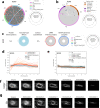This is a preprint.
A genome-wide atlas of human cell morphology
- PMID: 37609130
- PMCID: PMC10441312
- DOI: 10.1101/2023.08.06.552164
A genome-wide atlas of human cell morphology
Update in
-
A genome-wide atlas of human cell morphology.Nat Methods. 2025 Mar;22(3):621-633. doi: 10.1038/s41592-024-02537-7. Epub 2025 Jan 27. Nat Methods. 2025. PMID: 39870862 Free PMC article.
Abstract
A key challenge of the modern genomics era is developing data-driven representations of gene function. Here, we present the first unbiased morphology-based genome-wide perturbation atlas in human cells, containing three genome-scale genotype-phenotype maps comprising >20,000 single-gene CRISPR-Cas9-based knockout experiments in >30 million cells. Our optical pooled cell profiling approach (PERISCOPE) combines a de-stainable high-dimensional phenotyping panel (based on Cell Painting1,2) with optical sequencing of molecular barcodes and a scalable open-source analysis pipeline to facilitate massively parallel screening of pooled perturbation libraries. This approach provides high-dimensional phenotypic profiles of individual cells, while simultaneously enabling interrogation of subcellular processes. Our atlas reconstructs known pathways and protein-protein interaction networks, identifies culture media-specific responses to gene knockout, and clusters thousands of human genes by phenotypic similarity. Using this atlas, we identify the poorly-characterized disease-associated transmembrane protein TMEM251/LYSET as a Golgi-resident protein essential for mannose-6-phosphate-dependent trafficking of lysosomal enzymes, showing the power of these representations. In sum, our atlas and screening technology represent a rich and accessible resource for connecting genes to cellular functions at scale.
Conflict of interest statement
Conflicts of interest C.H.J. and J.Y. are employees of Calico Life Sciences LLC. S.S. and A.E.C. serve as scientific advisors for companies that use image-based profiling and Cell Painting (A.E.C: Recursion, SyzOnc, S.S.: Waypoint Bio, Dewpoint Therapeutics) and receive honoraria for occasional talks at pharmaceutical and biotechnology companies. P.C.B. is a consultant to or holds equity in 10X Genomics, General Automation Lab Technologies/Isolation Bio, Celsius Therapeutics, Next Gen Diagnostics, Cache DNA, Concerto Biosciences, Stately, Ramona Optics, Bifrost Biosystems, and Amber Bio. P.C.B.’s laboratory receives research funding from Merck and Genentech for work related to genetic screening. The Broad Institute and MIT may seek to commercialize aspects of this work, and related applications for intellectual property have been filed including WO2019222284A1 In situ cell screening methods and systems. All other authors declare no competing interests.
Figures
















References
-
- Doench J. G. Am I ready for CRISPR? A user’s guide to genetic screens. Nat. Rev. Genet. 19, 67–80 (2018). - PubMed
Publication types
Grants and funding
LinkOut - more resources
Full Text Sources
Research Materials
